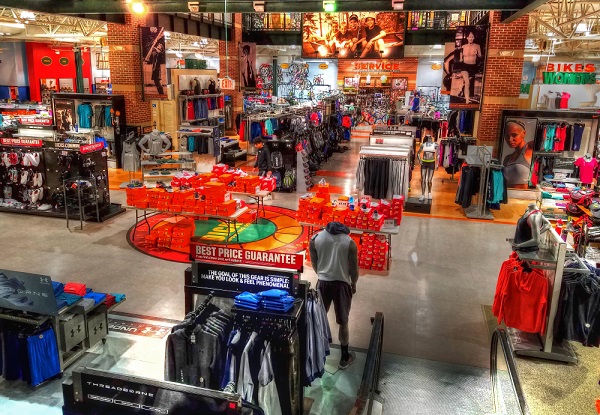Sporting Good Stores Need Faster Supply Chain

World Federation Sporting Goods Industry and partnering consulting firm McKinsey & Company identify the diminishing role of brick-and-mortar retail and the need for companies to charter paths for survival.
For years, as malls emptied out and 20th century middle-class staples like J.C. Penny and Macy’s diminished in the landscape of suburbia, experts have predicted the end for brick-and-mortar retail as we know it, including sporting good stores.
E-commerce and a change in consumer values to emphasize experience over ownership were blamed. The COVID-19 pandemic pushed late-comers into online shopping and revealed the array of products purchasable with a click (from cars to dog food). Battered by weeks of closure, an economic crisis and pre-existing pressures, many retailers filed for bankruptcy in 2020.
In such an environment, sporting good stores, including fitness specialty ones, cannot continue as they were, warns an annual report by the World Federation Sporting Goods Industry and its partnering consulting firm, McKinsey & Company. Brands will have to be nimble, adaptive to market forces and find some kind of niche that can’t be replicated online.
The report, titled “Sporting Goods 2021 – The Next Normal for an Industry in Flux,” also states that the diminished role of stores and increased importance of online ordering means that companies have to reevaluate product supply chains, making them more agile and equipped to fulfill quick customer demand.
“[S]porting goods companies need to offer clear and appealing propositions to attract consumers (back) to stores,” the report states. “Elements they may focus on include brand equity and the consumer experience, online fulfilment, category expertise, value offerings (where appropriate), immersive showrooms and streamlined service offerings.”
If that seems like an overload of goals — some of which contradict another, the report authors concur. “Of course, any single store is unlikely to be able to represent all of these,” they state, “instead, brands must identify formats and propositions that suit individual locations.”
The report lists a few options retailers should consider:
- Use preexisting networks of stores for online order fulfillment. Allow the customer to drive by to pick up their order, rather than wait for UPS. This has been a successful COVID-era strategy for Dick’s.
- Open outlet stores to diminish middle-man overhead and offer consumers cheaper goods, while also liquidating clearance items.
- Alternatively, open sleek and spacious flagship stores at prime locations to raise brand awareness and reputation.
- Hire experts and specialists who curate products and guide customers to the best ones for their purposes.
- Add or increase services that bring customers back to recycle, repair or trade in products. Patagonia is a trendsetter in this area.
- Allow customers to try products in more substantial ways than most sporting goods stores have in the past. The report cites as examples Switzerland’s Transa and Germany’s Globetrotter, outdoor supply sellers with climbing walls and rental services. Some Globetrotter stores even have water courses for canoe testing. Considering installing tracks and courts in the stores for customers to try out goods.
Finding the right combination of experiences and niches is possible, but difficult, the report warns. “Leading brands have shown that the right combination can both tempt customers away from their devices and turn physical retail into a focus for innovation. However, the role requires significant investment — which not all players can afford.”
As a diminishing role for storefront retails and an increasing reliance on online sales is inevitable, the report notes that sporting goods companies must adjust their supply chain. Online ordering calls for faster reaction times and manufactures have to shoulder more of the demands of market volatility, burdens once absorbed by wholesalers and retailers who warehoused the product as a necessity of getting it to the customers who come strolling in to shop.
In the old model, Asian suppliers made the products of large sporting good companies, requiring months of lead time from the start of production to sale to the consumer. Companies have tried to shorten this window to 120 days, then 90 or 60 or 30.
This may not be good enough, the report predicts. Sporting good companies should look for manufacturing options nearer to their online ordering and operations — or “near-shoring.” This would also allow companies to avoid some of the shocks to pricing and availability that occurred when COVID-19 disrupted global supply chains. The report advises that shorter supply chains could create “deeper partnerships that bring greater agility and accountability.”
Nick Keppler is a freelance journalist, writer and editor. He enjoys writing the difficult stories, the ones that make him pore over studies, talk about subjects that make people uncomfortable, and explain concepts that have taken years to develop. Nick has written extensively about psychology, healthcare, and public policy for national publications and for those locally- based in Pittsburgh. In addition to Athletech News, Nick has written for The Washington Post, The Daily Beast, Vice, Slate, Reuters, CityLab, Men’s Health, The Gizmodo Media Group, The Financial Times, Mental Floss, The Village Voice and AlterNet. His journalistic heroes include Jon Ronson, Jon Krakauer and Norah Vincent.



